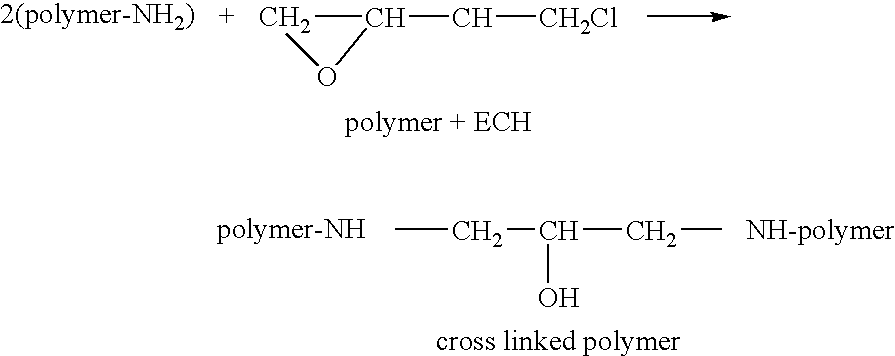Papermaking Additive
a papermaking additive and additive technology, applied in the field of papermaking additives, can solve the problems of material loss to effluent treatment, loss of valuable papermaking materials, and impairing their retention, and achieve the effect of enhancing the retention of components of papermaking stock and increasing paper strength properties
- Summary
- Abstract
- Description
- Claims
- Application Information
AI Technical Summary
Benefits of technology
Problems solved by technology
Method used
Image
Examples
example 1
Preparation of the Additive
[0061] Mycelium used as the starting material was a by-product from the production of citric acid which was dewatered to a solids content of 16.6% by pressing. 500 g of mycelium was placed in a reactor and 1270 g of 50% solution of sodium hydroxide was added. The blend was mildly agitated, heated to between 80 and 90° C. and maintained at this temperature for 2 hours. The entire mycelium dissolved forming a viscous solution. The solution was allowed to cool down and was diluted with 2500 g water. The strongly alkaline solution was then neutralized by adding 3820 g of 15% hydrochloric acid. The product had a weight of about 8100 g, pH between 8 and 9, and contained about 1% of organic solids. This product was tested as papermaking additive with no further modification.
example 2
Application of Novel Additive with Peroxide-Bleached Thermo Mechanical Pulp (BCTMP)
[0062] The additive prepared according to the Example 1 was added to an agitated 3% suspension of BCTMP in an amount that corresponded to 0.5% of organic solids calculated on dry pulp. Immediately after blending of the additive, handsheets were produced using the standard PAPTAC procedure. Handsheets were also produced from BCTMP with no additives and the properties of sets of handsheets were compared. Handsheets made with the novel additive had 9.8% greater breaking length (3.14 km as compared to 2.86 km), 21% greater Tensile Energy Absorption (TEA) index (490.7 mJ / g compared to 404.77 mJ / g) and 26.6% greater Scott Bond strength (290 J / m2 as compared to 229 J / m2). At the addition rate of 0.25% with respect to the organic solids, the Scott Bond strength was improved by 19.6% to 274 μm2.
example 3
More Economical Method of Preparation of the Additive that Requires a Smaller Amount of Sodium Hydroxide
[0063] 500 g of mycelium from the same source as in Example lwas placed in a reactor and 1270 g of a 10% solution of sodium hydroxide was added. The blend was mildly agitated, heated to between 80 and 90° C. and maintained at this temperature for 2 hours. The entire mycelium dissolved forming a viscous solution. The solution was allowed to cool down and diluted with 3010 g water. The strongly alkaline solution was then neutralized to a pH between 8 and 9. This product was tested as papermaking additive with no further modification.
PUM
| Property | Measurement | Unit |
|---|---|---|
| temperatures | aaaaa | aaaaa |
| temperatures | aaaaa | aaaaa |
| temperature | aaaaa | aaaaa |
Abstract
Description
Claims
Application Information
 Login to View More
Login to View More - R&D
- Intellectual Property
- Life Sciences
- Materials
- Tech Scout
- Unparalleled Data Quality
- Higher Quality Content
- 60% Fewer Hallucinations
Browse by: Latest US Patents, China's latest patents, Technical Efficacy Thesaurus, Application Domain, Technology Topic, Popular Technical Reports.
© 2025 PatSnap. All rights reserved.Legal|Privacy policy|Modern Slavery Act Transparency Statement|Sitemap|About US| Contact US: help@patsnap.com

